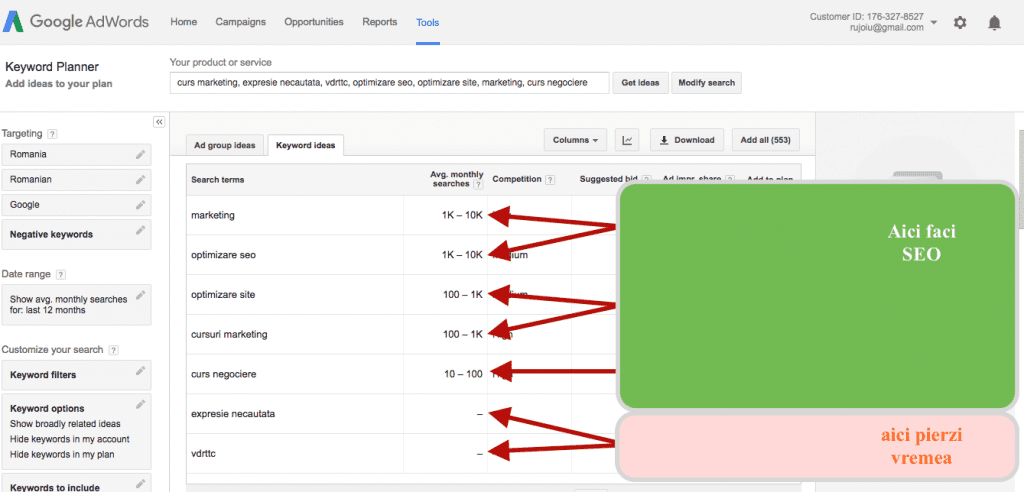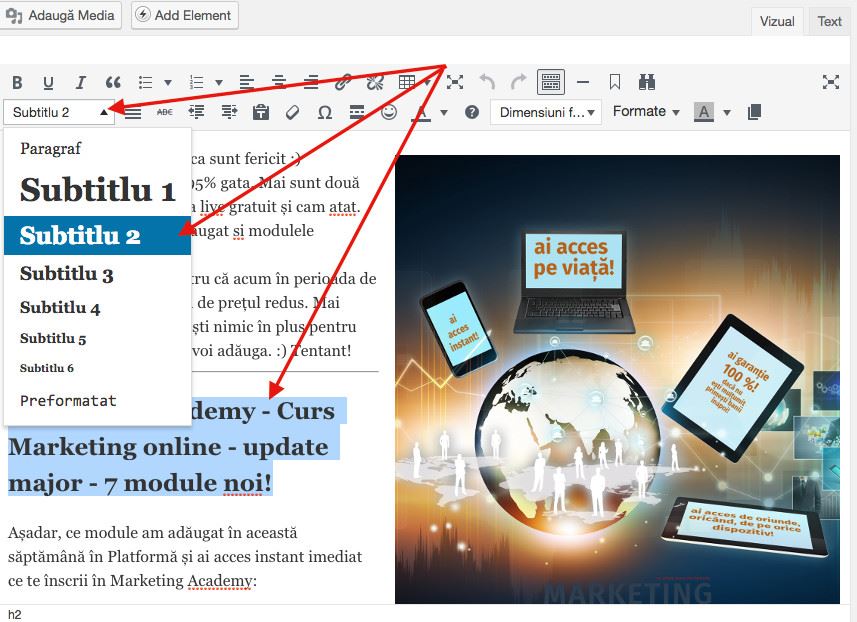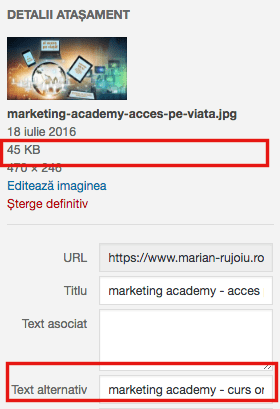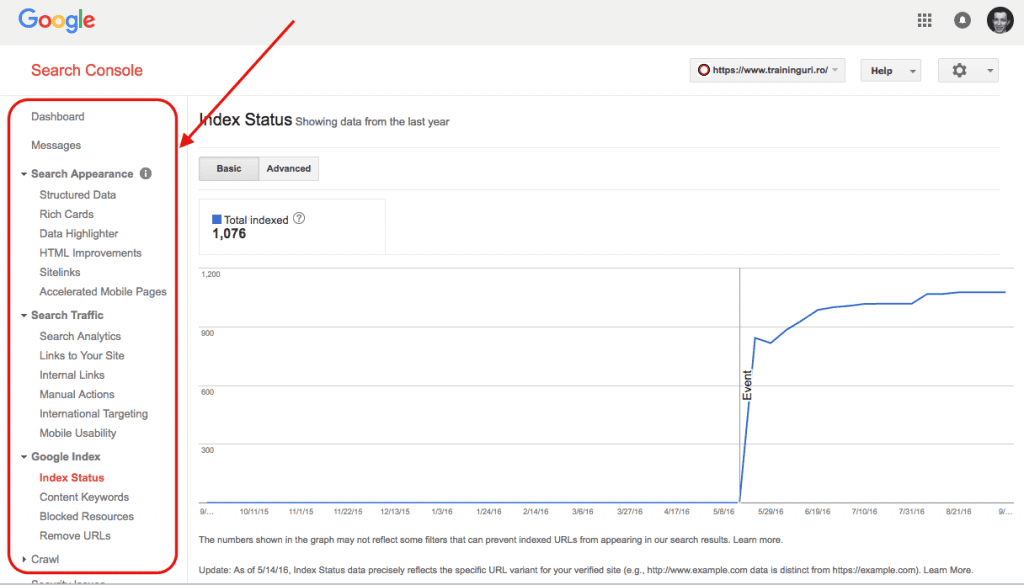SEO optimization - over 20 free and concrete tips from Panda SEO specialists
SEO is a challenging field. In English it means optimizing your website for search engines. Whether we like it or not, when we talk about search engines, at least in Romania, we mostly mean Google. In this article you will find a list of the main things you can do to optimize your website. The abbreviation SEO comes from the English language: Search Engine Optimization.
If you do a google search after:SEO optimization or website optimization you will find a lot of companies that can offer you SEO services. I didn't write this article to offer you SEO services because I don't do that. I wrote this article for anyone searching on google: SEO optimization to understand in the most accessible language possible what this SEO optimisation entails, what it means in concrete terms.
Whether you want to do SEO yourself or outsource all or part of it, it's good to know what SEO entails. I have personally taken care of the traininguri.ro website which is one of the top three positions in google for what we are interested in, such as: human resources manager course, trainer course, public procurement course, sales training, etc.)
See what we did below. It's a summary, a kind of checklist. I talk about many aspects in depth in the Online Marketing course.
So what could you do for SEO optimization?
1. Use keyword planner
From my point of view this is the zero step you need to take. The reason is simple: from the beginning you need to know exactly what you want to achieve, on which phrases you want to rank well in google rankings. I mean, there's no point indexing and optimizing for SEO what people don't search for.
Act smart from the start and optimise for what interests you. In detail, I show how to do this in marketing academy, module 7. Anyway, the basic idea is simple: determine which phrases you want to do SEO on and check in keyword planner what volume of queries you have on the expression(s).
2. Install a tool to help with SEO optimization
It depends on what platform you have your website on, I prefer wordpress. For wordpress you install Yoast pluginwhich is free and tells you exactly what you do well and what you don't do well. It's easy to use. In module 5 of Marketing Academy, I also provide a case study so you can see exactly how it is used. As long as you use it intelligently, at least for the SEO basis of every article on your website it's enough.
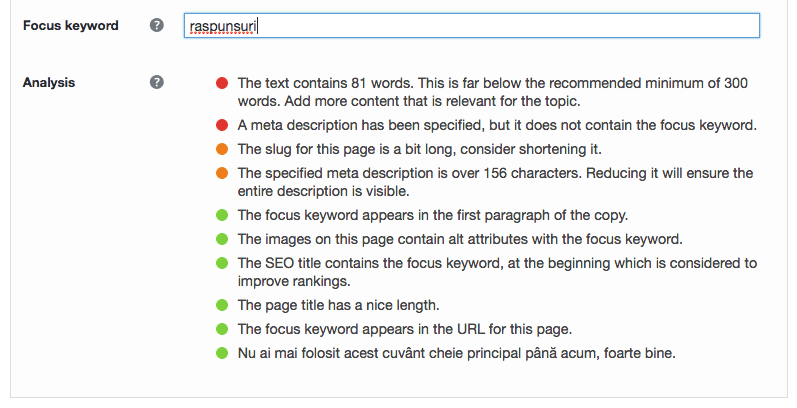
3. Optimise your article titles
Basically, once you've decided to target a keyword or phrase it should appear in the title of your article. It is important that it is relevant and clear.

4. Link optimization
I prefer, that once I have targeted a keyword, beyond the website name, the link should be exactly the keyword. It's also friendly for google and users.

5. Optimising meta descriptions
When you publish an article, you must also add a meta description. This is a kind of google readable summary. Basically, from the title, link and meta description, google understands what the article is about.
Usually but not always this meta description appears in google. And this meta description must contain the key phrase, be relevant to the phrase you are targeting and also attractive and relevant to the user who sees it in google. For this meta description you have a box in Yoast.

6. Optimising the introduction and content
There are many theories on how often the keyword should appear in the article. Personally I don't think there is a true 100% answer. Obviously it should appear a few times, a minimum of 3-5 times, however how much you stretch yourself with inserting the key phrase in the article is more a matter of common sense.
When you feel you're overdoing it, you'd better stop, because google will draw the same conclusion. So put your keyword in the first paragraph, then in the text. The idea is that you should make the frequency of the keyword natural once you write about the thing.
7. Optimising headings and subheadings
When you publish an article you can choose what is the title and what is the subtitle. Think of these headings and subheadings as a kind of table of contents. These headings help Google understand the structure of your article. Obviously it will also help the user with this content organization.
Basically, in the headings and subheadings of the article, instead of choosing to visually identify the headings by setting a larger or smaller font size, you use the heading option 1, 2, 3, or 4. If you install wordpress in English you will see exactly as in the image below (subtitle 1, subtitle 2, etc). I usually think of this structure before writing the article, but you can do it afterwards.
8. Optimising images in content
Three things are important when it comes to images:
- relevance of the photo to the key phrase
- optimise it in terms of size (not too big, i.e. somewhere around 100 KB maximum)
- add other text (alternative text) containing the keyword on at least one of the photos (if you have more than one)
9. Inserting external and external links
They are called inbound links or outbound links. It is recommended that you insert at least one or two links to other content on your article (inbound link) and one link to an external site. It is preferable that the links are relevant and helpful to the user and not artificially placed just because they have to be placed.
10. Adding tags and categories
At the end of the articles you need to add tags. Here you insert relevant phrases from which it is briefly understood what topics your article touches on. Here you can also insert expressions from the word family of the targeted expression, on the only condition that you have talked about it in the article. If you haven't, you risk a penalty from Google.
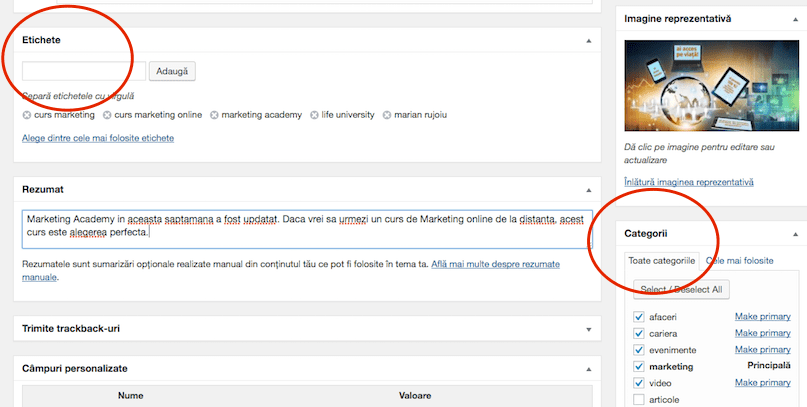
11. Content relevance is vital for SEO
When I say relevant, I mean primarily to the reader. If you don't have relevant and good quality content you don't meet points 1-10 above. This is where the line is drawn! If the article is not a good one, you can optimize 1 000 yearsYou can try to enter as many keywords as you want, you can respect everything. Basically you have to write with impact, whether we're talking about a product presentation or a resource article. This is where the first problem for external consultants comes in.
They can help you with points 1-10, but with this point it's hard for an outsider to create quality, relevant content for your audience. I've also heard complaints that they paid consultants who didn't get results. I complained about this too, until I understood what a consultant can and can't do. It's not his fault at the relevance of the content. That's where it's your job, or the content manager in the company. In module 9 of the Marketing Academy I explain how to write impactful articles that generate customers. However, the key is relevance.
12. SEO strategy to target the first position in Google
You're probably interested in SEO if you've made it this far, but you're probably not just interested in seo optimization in general, but you want optimization that will get you on the first page of google and why not the top positions? SBeing on the front page is sometimes not enough.
Users, when searching in google, click on the first position below 50%, on the second position 20-30%, on the third position in google below 20 %, etc. Basically, if you are not in one of the first three positions you attract less than 10 % of those who search for that phrase.
This percentage may differ from domain to domain and may vary depending on how much advertising appears before the first position or how attractive your site's title and description appear. Basically, in addition to writing relevant to your audience, you also need to write cleverly to outperform your competitors.
13. Optimize the entire site for SEO
It is important to note that points 1-12 apply to every page or article you put on your website. That is, above you don't have the general tips, you have the things you need to do for each article, service or product on your website.
When you think about website optimization or SEO optimization of your entire website, the basis is on every article on your website. That means overall website optimization comes only later and there is not much to do. The basis is in every article, I mean everything you post on the site. Basically, general SEO optimization is the sum of all the optimizations you do for each content you publish on your website.
14. Optimising categories and tags
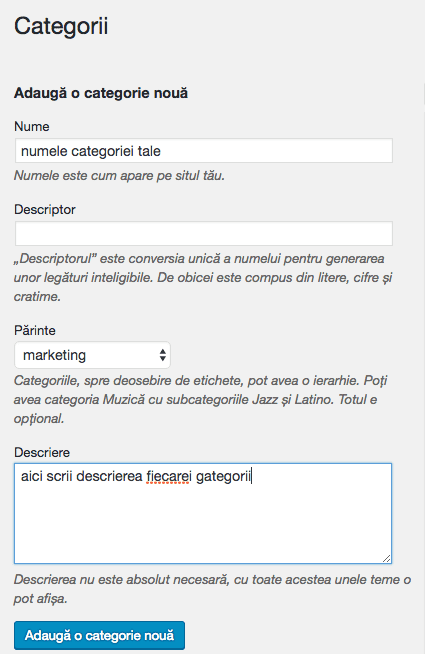
Here you still use the Yoast plugin or wordpress options. You set it up by following the instructions, then go to categories and add your description for each category on the same principle as for articles. That is, for each category on your site you enter a meta description, which will also appear in google. In google you will see that sometimes google gives you a page, sometimes a category. It depends on what it considers most relevant. See how it already displays on your domain and follow the same strategy. Either way, my recommendation is to put category descriptions. Likewise, if you index from Yoast settings and tags, you should do the same with them. Here the discussion is longer, you can watch a yoast config tutorial on the internet to see what works best for you.
15. Use verification tools
I, for example, use SEO doctor. You install it in your browser and check what you've done. It tells you if technically it's ok or not, and it also tells you what errors you have. It's a good tool, you can search for similar variants. This tool also makes it easy to see what your competition is doing, because it gives you the summary of your competition. It's good sometimes not to invent the wheel and see what your competition is doing.
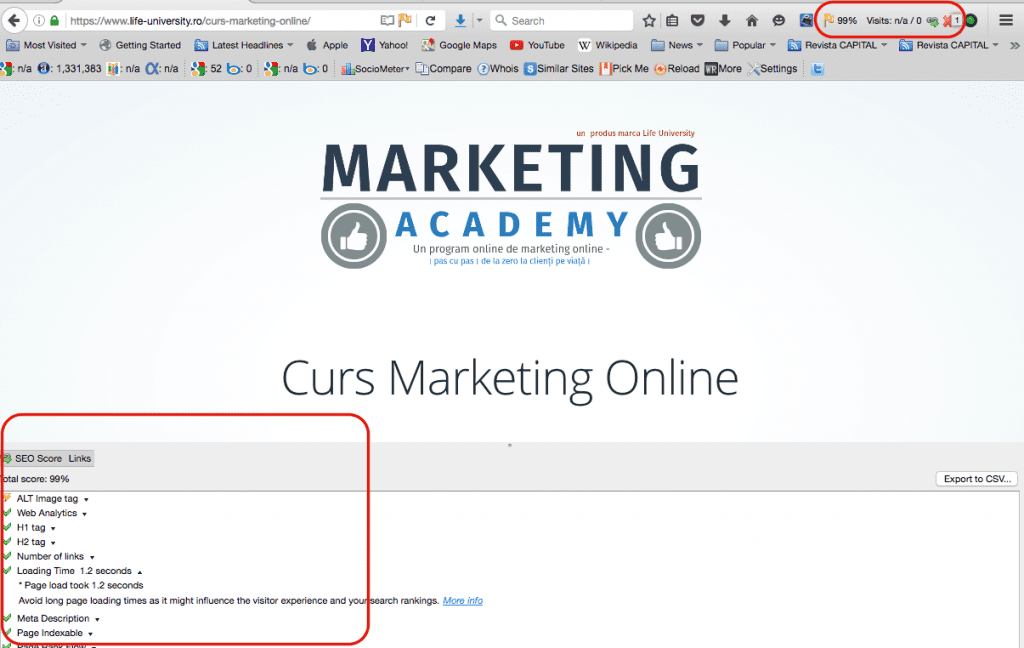
16. Website loading speed is important for SEO
Beyond your impression that your website loads fast or not, use verification tools. The best ones are pingdom and google page speed. Test the loading speed not only of the home page, but also of each article once you publish it. If it hits red you need a programmer to help you. This is where I have my biggest dispute with programmers...because I'm never satisfied.  There are plugins too, but this is another big topic that maybe I'll clear up another time. If you want a tool that measures your entire site end-to-end, page by page, you can install pagespeed insight, a wordpress plugin.
There are plugins too, but this is another big topic that maybe I'll clear up another time. If you want a tool that measures your entire site end-to-end, page by page, you can install pagespeed insight, a wordpress plugin.
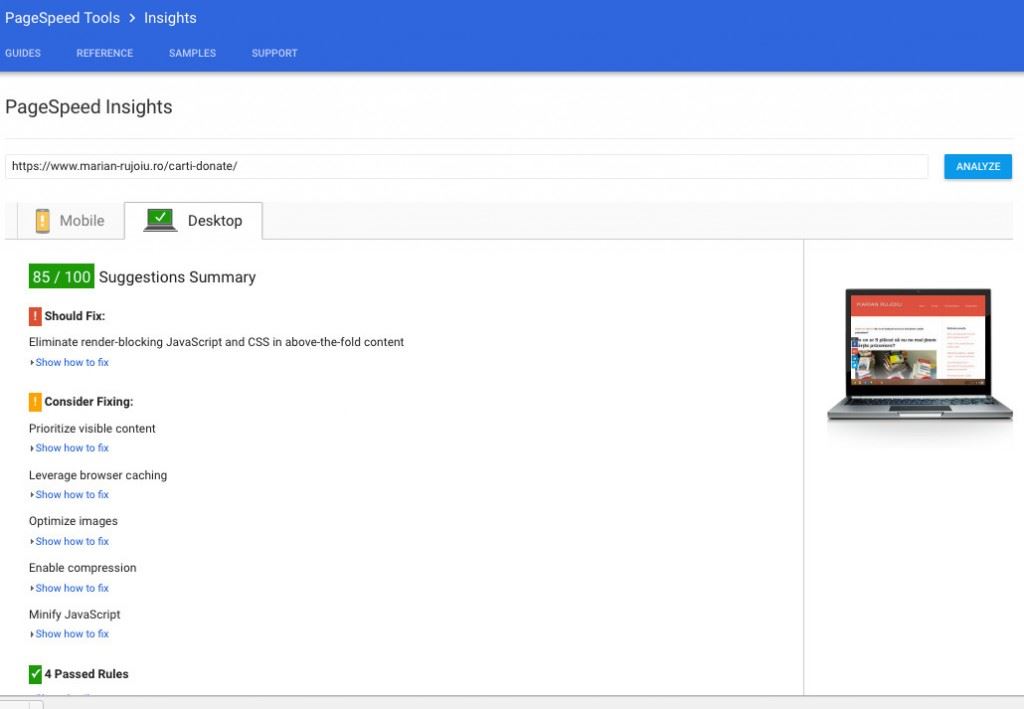
17. Optimising for mobile
Google has officially announced that this matters, in that they will penalize websites that are not friendly to their Mobile View. To test your site use google Mobile Friendly Testbeyond testing it on your phone. There it tells you exactly how you're doing with the website 
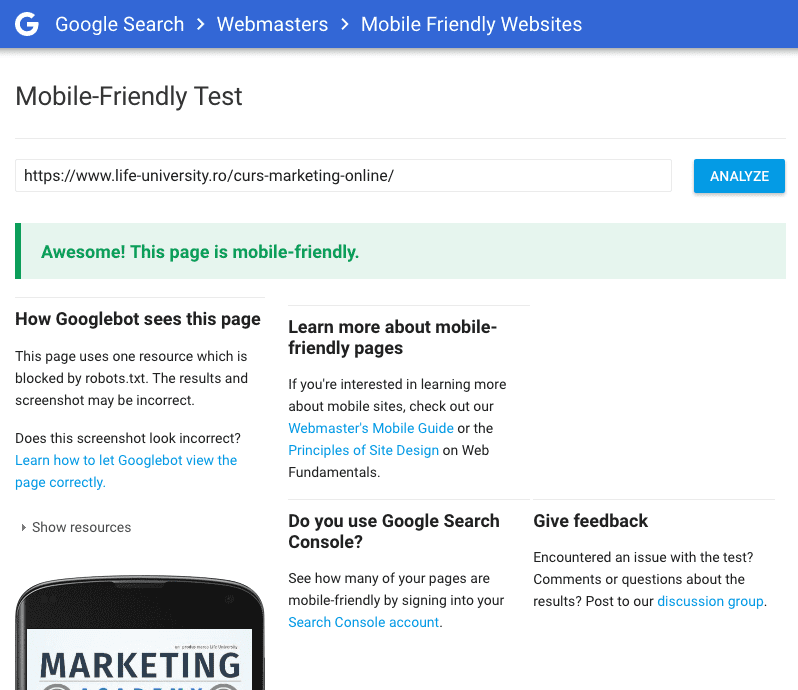
18. General site hygiene
Google says it doesn't influence this much, but I have my doubts  However if you're not thinking about google, think about the visitors to your site. It is important to have a clean site, this means no errors. To see if there are errors on your site, connect your site to google webmaster tools and you will see if you have errors on the site or not.
However if you're not thinking about google, think about the visitors to your site. It is important to have a clean site, this means no errors. To see if there are errors on your site, connect your site to google webmaster tools and you will see if you have errors on the site or not.
It will tell you exactly what errors you have. Some you'll be able to fix yourself, for others you'll probably need a specialist. Also webmaster tools shows you exactly which google phrases people are coming to your site from. That is, you can see where you rank and how many people click on your website. Also in webmaster tools you can see if your website has any structural problems or errors that you might want to fix. Webmaster Tools connects to your website in the same way as Google Analytics.
19. General site indexing using sitemap
Also in webmaster tools you will see if your website's sitemap is seen by goole. The sitemap automatically sends it to yoast if you use it. Still, a check never hurts.
20. Homepage optimization
You will see that for certain key phrases, google offers a site's hompage in its results and not necessarily an article. This is basically for two reasons:
- The hompage of that site is optimized according to all the points we have discussed so far.
- That site is highly relevant to that phrase, i.e. it has a lot of content on that topic.
You can do the same, optimise your hompage correctly and put a lot of quality content on the domain.
21. Use https protocol instead of http
Talk to the webmaster of your website to have a security certificate installed. This matters to google because it confirms an identity of the site owner and that there is a secure connection. Some certificates are free, others are for a fee. The ones for a fee have certain advantages. It's best to have a discussion with your hosting company (where you host your site). More about
22. Back Links or link building from outside
It has long been fashionable to list your website in a thousand web directories on the internet. That is, linking to your site from different sites. It used to matter a lot to google. As this was abused, with links being placed on sites that had nothing to do with the site being promoted, google said no.
Now only links that are relevant to your website matter to google. I mean, if on a blog someone talks about your services and puts a link to your website it's ok, but if you go ahead and link to your website on ad sites it doesn't help you much, on the contrary if the reputation of the site you are linking to is bad, or is mainly used for something like that it is worse for you than it helps you.
This is also where the links you get from social networks such as Facebook, Google+, Linkedin, twiter, etc. The most valuable for SEO is Google +, especially since posts on google plus also show up in google searches.
22. SEO optimization for visitors and then for Google
The main mistake those inexperienced in seo optimization make is to abuse Yoast or keywords in an attempt to trick Google. I have often heard the complaint that google has changed its algorithm and we don't show up in searches. I talk about this more in Marketing Academy, however if I were to give you a short answer it would be this: sorry, if google changes its algorithm and your site is affected.
This means that you have done things wrong or that you have tried to circumvent google. Google can't be fooled, at worst you fool it in the short term. In the long term, it doesn't change its algorithm, it actually removes the irrelevant ones, the ones that try to trick it, from searches. If you write strategically and beautifully for your users and don't abuse it, you'll stay in google forever.
At least I have been doing it for 10 years. Think first and foremost of your users when doing SEO and you leave with maximum chances from the start. Google, at the end of the day, takes into account what users do, so if you are relevant and fair to users, google has no problem. The moment you're not relevant, google moves you to the bottom of the list favouring the relevant ones. You can install google analytics to see exactly what visitors are doing on your website. A good indicator is the bounce rate which should be as low as possible, then the average number of pages viewed per visit, the time spent on the page.
24. Constantly measure the SEO performance of your website.
Apart from google analytics, webmaster tools you can also test other tools for monitoring your website such as: AFREHS, SEO MOZ, Majestic SEO, etc. Test it and see what helps.
How quickly can you expect results if you do SEO optimization?
If you do SEO smart, if things are done right, an article (post, product, service, etc) can reach the front page within 2-5 months. It depends on how well it's done, what the competition is in that area, and how old and relevant your website is to that area.
I usually aim for one of the top three positions, and when I allocate time, attention and stick to the strategies, it takes me a maximum of 6 months to reach one of the top three positions. At the level of detail it's hard to stick to everything I wrote above. It's hard for me too, sometimes I forget, sometimes I don't have the patience, but when I aim and allocate attention, I do these things as best I can. Sometimes I consciously make certain compromises. And on this page I have made some compromises, I leave it to you to discover what they are 
Should you do your own SEO or call in the specialists?
Honestly, you do as you please. i think SEO specialists can help you too, you can do it yourself or you can go on a combination between you and them. There are however some aspects that no one can do better than you who know your business and your customers. The purpose of this article was to show you as clearly and briefly as possible what exactly SEO optimization entails in terms of execution. I hope it is now clearer to you. You can decide exactly which areas of these 20+ tips you can do yourself and which areas you want to outsource. But I'm sure you'll make informed decisions, which is essential in my view 
Recommended Posts

Top 40 eCommerce trends for 2022
30/07/2021
